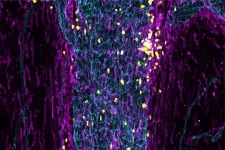(Press-News.org) Alzheimer's disease, multiple sclerosis, autism, schizophrenia and many other neurological and psychiatric conditions have been linked to inflammation in the brain. There's growing evidence that immune cells and molecules play a key role in normal brain development and function as well. But at the core of the burgeoning field of neuroimmunology lies a mystery: How does the immune system even know what's happening in the brain? Generations of students have been taught that the brain is immunoprivileged, meaning the immune system largely steers clear of it.
Now, researchers at Washington University School of Medicine in St. Louis believe they have figured out how the immune system keeps tabs on what's going on in the brain. Immune cells are stationed in the meninges -- the tissue that covers the brain and spinal cord -- where they sample fluid as it washes out of the brain. If the cells detect signs of infection, disease or injury, they are prepared to initiate an immune response to confront the problem, the researchers said.
The findings, published Jan. 27 in the journal Cell, open up the possibility of targeting immune cells at such surveillance sites as a means of treating conditions driven by brain inflammation.
"Every organ in the body is being surveilled by the immune system," said senior author Jonathan Kipnis, PhD, the Alan A. and Edith L. Wolff Distinguished Professor of Pathology & Immunology. "If there's a tumor, an injury, an infection anywhere in the body, the immune system has to know about it. But people say the exception is the brain; if you have a problem in the brain, the immune system just lets it happen. That never made sense to me. What we've found is that there is indeed immune surveillance of the brain -- it's just happening outside the brain. Now that we know where it's happening, that opens up lots of new possibilities for modulating the immune system."
In 2015, Kipnis and colleagues found a network of vessels that drains fluid and small molecules from the brain into the lymph nodes, where immune responses are initiated. The discovery demonstrated a direct physical connection between the brain and the immune system. But the network of vessels represented an exit from the brain. It remained unclear where immune cells entered or surveilled the brain.
Kipnis and Justin Rustenhoven, PhD, a postdoctoral researcher and the first author on the new paper, set out to find the immune system's gateway to the brain. They saw a clue in the fact that the vessels containing fluid leaving the brain run alongside sinuses in the dura mater, the tough outer layer of the meninges just underneath the skull. Dural sinuses, which contain blood that carries immune cells, lack the tight barrier that elsewhere keeps blood separate from the brain.
Experiments showed that the dural sinuses were packed with molecules from the brain and immune cells that had been carried in with blood. Multiple kinds of immune cells were represented, including some that pick up and display suspect molecules from the blood and others that scan the suspect molecules and respond to them by mounting a defense.
"Imagine if your neighbors went through your trash every day," said Kipnis, also a professor of neurosurgery, of neurology and of neuroscience. "If they start finding blood-stained towels in your trash, they know something is wrong. It's the same thing with the immune system. If patrolling immune cells see tumor antigens or signs of infection from the brain, the cells know there's a problem. They will take that evidence to immune headquarters, which is the lymph nodes, and initiate an immune response."
The findings suggest that the immune system surveils the brain from a distance and only enters when it finds a problem. This could explain why the brain was thought for so long to be immunoprivileged.
"Immune activity in the brain can be highly detrimental," Rustenhoven said. "It can kill neurons and cause swelling. The brain can't tolerate much swelling because the cranium is a fixed volume. So immune surveillance is pushed to the borders, where the cells can still monitor the brain but don't risk damaging it."
Multiple sclerosis is a degenerative condition in which the immune system attacks the protective sheath on nerves, causing communication problems between the brain and the rest of the body. The cause is unknown. Using a mouse model of multiple sclerosis, the researchers showed that initiation of disease triggered a massive accumulation of activated immune cells in the dural sinuses, suggesting that harmful immune responses may begin in the dura mater and spread to the brain.
Further work is needed to verify the role of dural sinuses in neuroinflammatory conditions. But the location of the sinuses just on the inside of skull on the accessible side of the blood-brain barrier suggests possibilities for targeting the immune system in that area.
"If this is a gateway to the brain, we can attempt to manipulate the area with therapies aimed at preventing over-activated immune cells from entering the brain," Kipnis said. "The dura is close to the surface, so we may even be able to deliver drugs through the skull. In theory, you could come up with an ointment that diffuses through the skull bone and reaches the dura. We might have found where inflammatory responses for many neuroimmunological conditions start, and there's so much we can do with that."
INFORMATION:
What makes cancer cells different from ordinary cells in our bodies? Can these differences be used to strike at them and paralyze their activity? This basic question has bothered cancer researchers since the mid-19th century. The search for unique characteristics of cancer cells is a building block of modern cancer research. A new study led by researchers from Tel Aviv University shows, for the first time, how an abnormal number of chromosomes (aneuploidy) -- a unique characteristic of cancer cells that researchers have known about for decades -- could become a weak ...
Biologists believe they are one step closer to a long-held goal of making a cheap, widely available plant a source for energy and fuel, meaning one of the next big weapons in the battle against climate change may be able to trace its roots to the side of a Texas highway.
Researchers at The University of Texas at Austin, HudsonAlpha Institute for Biotechnology, the U.S. Department of Energy (DOE) and other institutions have published a complex genome analysis of switchgrass, a promising biofuel crop.
The team tied different genes to better performance in varying climates across North America, which now gives scientists a road map for breeding ...
A high proportion of survivors of Ebola experienced a resurgence in antibody levels nearly a year after recovery, a new University of Liverpool study has found.
Published today in Nature, the finding hints that hidden reservoirs of virus could exist long after symptoms ease and has implications for monitoring programmes and vaccine strategies.
When a person is infected with Ebola virus, their body produces antibodies to fight the disease. Antibody concentrations peak and then decline slowly over time, providing the body with some degree of immune protection ...
Researchers have discovered a novel and druggable insulin inhibitory receptor, named inceptor. The latest study from Helmholtz Zentrum Muenchen, the Technical University of Munich and the German Center for Diabetes Research is a significant milestone for diabetes research as the scientific community celebrates 100 years of insulin and 50 years of insulin receptor discovery. The blocking of inceptor function leads to an increased sensitisation of the insulin signaling pathway in pancreatic beta cells. This might allow protection and regeneration of beta cells for diabetes remission.
Diabetes mellitus is a complex disease characterized by the loss or dysfunction of insulin-producing beta cells in the islets of Langerhans, ...
Linking molecular components through amide bonds is one of the most important reactions in research and the chemical industry. In the journal Angewandte Chemie, scientists have now introduced a new type of reaction for making amide bonds. Called an ASHA ligation, this reaction is fast, efficient, works under mild aqueous conditions, and is broadly applicable.
Amide bonds are the bond between a carbonyl carbon (C=O) and an organic nitrogen atom. It is amide bonds that link individual amino acids together into proteins and bind monomers into polyamide plastics like perlon ...
Researchers at Vanderbilt University Medical Center (VUMC) and the University of Texas Medical Branch (UTMB) at Galveston have discovered what may be the Achilles' heel of the coronavirus, a finding that may help close the door on COVID-19 and possibly head off future pandemics.
The coronavirus is an RNA virus that has, in its enzymatic toolkit, a "proofreading" exoribonuclease, called nsp14-ExoN, which can correct errors in the RNA sequence that occur during replication, when copies of the virus are generated.
Using cutting-edge technologies and novel bioinformatics approaches, the researchers discovered that this ExoN also regulates the rate of recombination, the ability of the coronavirus ...
Reaching zero net emissions of carbon dioxide from energy and industry by 2050 can be accomplished by rebuilding U.S. energy infrastructure to run primarily on renewable energy, at a net cost of about $1 per person per day, according to new research published by the Department of Energy's Lawrence Berkeley National Laboratory (Berkeley Lab), the University of San Francisco (USF), and the consulting firm Evolved Energy Research.
The researchers created a detailed model of the entire U.S. energy and industrial system to produce the first detailed, peer-reviewed study of how to achieve carbon-neutrality by 2050. According to the Intergovernmental Panel on Climate Change (IPCC), the world must reach zero net CO2 ...
CHAMPAIGN, Ill. -- Culture, civic-mindedness and privacy concerns influence how willing people are to share personal location information to help stem the transmission of COVID-19 in their communities, a new study finds. Such sharing includes giving public health authorities access to their geographic information via data gathered from phone calls, mobile apps, credit card purchases, wristband trackers or other technologies.
Reported in the International Journal of Geo-Information, the study will help public health officials better tailor their COVID-19 mitigation strategies to specific cultural contexts, the ...
Climate change mitigation is about more than just CO2. So-called "short-lived climate-forcing pollutants" such as soot, methane, and tropospheric ozone all have harmful effects. Climate policy should be guided by a clearer understanding of their differentiated impacts.
It is common practice in climate policy to bundle the climate warming pollutants together and express their total effects in terms of "CO2 equivalence". This 'equivalence' is based on a comparison of climate effects on a 100-year timescale. This approach is problematic, as IASS scientist Kathleen ...
In a new article published in the scientific journal Communications Chemistry, a research group at Uppsala University show, using computer simulations, that ions do not always behave as expected. In their research on molten salts, they were able to see that, in some cases, the ions in the salt mixture they were studying affect one another so much that they may even move in the "wrong" direction - that is, towards an electrode with the same charge.
Research on the next-generation batteries is under way in numerous academic disciplines. Researchers at the Department of Cell and Molecular Biology, Uppsala University have developed and studied a model for alkali halides, of which ordinary table salt (sodium chloride) is the best-known example. If these ...







